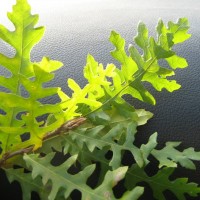
Turkey Oak - Quercus cerris
Expand and collapse the sections below by clicking on the title or + / - icons.
Short description of Quercus cerris, Turkey Oak
A large, spreading, deciduous tree up to 40 m tall. The male flowers are catkins, the female flowers give rise to acorns, with bristly cups.
Impact summary: Quercus cerris, Turkey Oak
Turkey oak can invade semi-natural habitats such as woodland and lowland heath. In built-up areas, the roots can damage structures.
Habitat summary: Quercus cerris, Turkey Oak
An important woodland tree in its native range, in GB it occurs in woodlands, brownfield sites and on heaths.
Overview table
| Environment | Terrestrial |
|---|---|
| Species status | Non-Native |
| Native range | Europe, Asia-Temperate, Southeastern Europe, Northern Africa, Turkey |
| Functional type | Land plant |
| Status in England | Non-Native |
| Status in Scotland | Non-Native |
| Status in Wales | Non-Native |
| Location of first record | v.c.30 |
| Date of first record | 1844 |
Origin
Native to southern Europe and Turkey.
First Record
Planted in GB by the early 18th century, recorded in the wild since 1905.
Pathway and Method
Specimen trees in parks and gardens produce adundant seed which are dispersed by animals as with native British oaks.
Species Status
Widely naturalised in southern GB, also throughout much of Europe beyond its native range, except for the far north. It has been recorded from 1425 10km squares in the British Isles up to 2010; 738 squares were recorded between 1970 and 1986 and 1151 from 1987 to 1999.
Dispersal Mechanisms
The acorns are dispersed by animals, probably jays and squirrels as with the native oaks.
Reproduction
Wind-pollinated and monoecious, with separate male and female flowers on the same tree. The acorns ripen in the second year.
Known Predators/Herbivores
Susceptible to browsing by mammals, but not to the same extent as the native oaks, also fewer insects feed on Turkey Oak than the native species. It is the host of the sexual stages of the Marble Gall and the Knopper Gall, both of whose parthenogenetic stages affect native oaks. Trees infected with ‘sudden oak death’ Phytophthora ramorum have been seen in southeast England, but the effect does not seem to as serious as in other species.
Resistant Stages
Once ripe, the acorns germinate fairly rapidly and lose viability if allowed to dry out.
Habitat Occupied in GB
Woodland, hedges, scrub, waste ground and brownfield sites.
Throughout GB, but mostly in England south of a line between the Mersey and the Humber, less frequent in Wales, Scotland and northern England.
Environmental Impact
Can invade woodland and lowland heath. Host of the sexual stages of both the Knopper Gall and the Marble Gall, the gall wasps provide food for birds early in the season.
Health and Social Impact
None known.
Economic Impact
Originally considered as a timber tree, as it grows relatively rapidly and on poor soil. However, the timber is inferior to that of the native British oaks and is prone to splitting.
Identification
Stace, C.A. (2010) New flora of the British Isles, Third Edition, Cambridge University Press, Cambridge.
Biology, ecology, spread, vectors
Botanical Society of the British Isles. Vascular Plant Atlas Update Project http://www.bsbimaps.org.uk/atlas/ [March 2011].
The Times (2008). http://www.timesonline.co.uk/tol/news/environment/article4553496.ece [March 2011]
Forestry Commission. Exotic Pest Alert Phytophthora ramorum http://www.forestry.gov.uk/pdf/EPAversion3.pdf/$FILE/EPAversion3.pdf [March 2011]
Management and impact
Natural England (2009). Shire horses assist in local nature conservation effort. http://www.naturalengland.org.uk/regions/south_west/press_releases/2009/141009.aspx [March 2011]
General
Bean, W.J. (1976) Trees and Shrubs Hardy in the British Isles, 8th edn, Vol III. John Murray, London.
Ecological Flora of the British Isles http://www.ecoflora.co.uk/search_species2.php?plant_no=360030090 [March 2011].
Wikipedia. Turkey Oak http://en.wikipedia.org/wiki/Turkey_Oak [February 2011]
Spotted this species?
Distribution map
View the Distribution map for Turkey Oak, Quercus cerris from BSBI
ID Sheet
ID Sheet for Quercus cerris . See a full list of non-native species ID Sheets.


